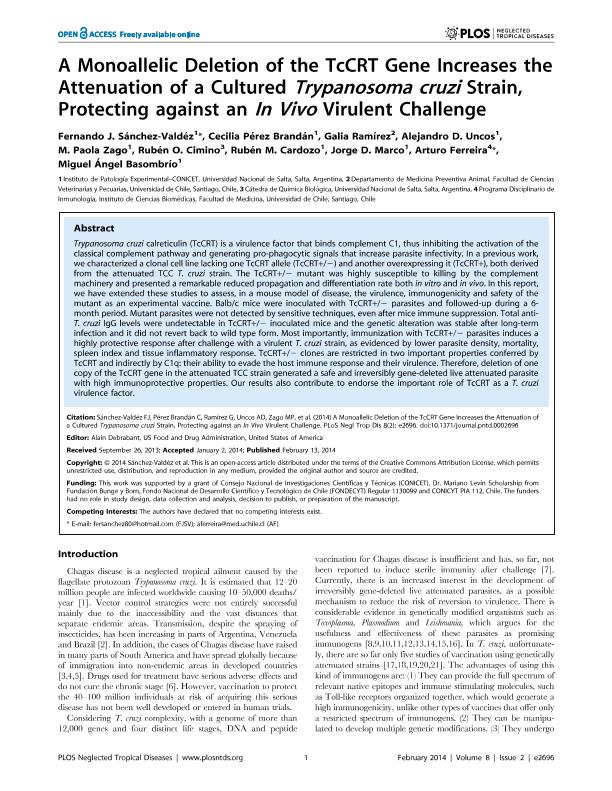Mostrar el registro sencillo del ítem
dc.contributor.author
Sánchez Valdéz, Fernando Javier

dc.contributor.author
Perez Brandan, Cecilia Maria

dc.contributor.author
Ramirez, Galia
dc.contributor.author
Uncos, Delfor Alejandro

dc.contributor.author
Zago, María Paola

dc.contributor.author
Cimino, Ruben O.
dc.contributor.author
Cardozo, Ruben M.
dc.contributor.author
Marco, Jorge Diego

dc.contributor.author
Ferreira, Arturo
dc.contributor.author
Basombrio, Miguel Angel Manuel

dc.date.available
2016-08-11T15:42:49Z
dc.date.issued
2013-02-13
dc.identifier.citation
Sánchez Valdéz, Fernando Javier; Perez Brandan, Cecilia Maria; Ramirez, Galia; Uncos, Delfor Alejandro; Zago, María Paola; et al.; A Monoallelic Deletion of the TcCRT Gene Increases the Attenuation of a Cultured Trypanosoma cruzi Strain, Protecting Against an in Vivo Virulent Challenge; Public Library of Science; Neglected Tropical Diseases; 8; e269; 13-2-2013; 234-237
dc.identifier.issn
1935-2735
dc.identifier.uri
http://hdl.handle.net/11336/7093
dc.description.abstract
Trypanosoma cruzi calreticulin (TcCRT) is a virulence factor that binds complement C1, thus inhibiting the activation of the classical complement pathway and generating pro-phagocytic signals that increase parasite infectivity. In a previous work, we characterized a clonal cell line lacking one TcCRT allele (TcCRT+/-) and another overexpressing it (TcCRT+), both derived from the attenuated TCC T. cruzi strain. The TcCRT+/- mutant was highly susceptible to killing by the complement machinery and presented a remarkable reduced propagation and differentiation rate both in vitro and in vivo. In this report, we have extended these studies to assess, in a mouse model of disease, the virulence, immunogenicity and safety of the mutant as an experimental vaccine. Balb/c mice were inoculated with TcCRT+/- parasites and followed-up during a 6-month period. Mutant parasites were not detected by sensitive techniques, even after mice immune suppression. Total anti-T. cruzi IgG levels were undetectable in TcCRT+/- inoculated mice and the genetic alteration was stable after long-term infection and it did not revert back to wild type form. Most importantly, immunization with TcCRT+/- parasites induces a highly protective response after challenge with a virulent T. cruzi strain, as evidenced by lower parasite density, mortality, spleen index and tissue inflammatory response. TcCRT+/- clones are restricted in two important properties conferred by TcCRT and indirectly by C1q: their ability to evade the host immune response and their virulence. Therefore, deletion of one copy of the TcCRT gene in the attenuated TCC strain generated a safe and irreversibly gene-deleted live attenuated parasite with high immunoprotective properties. Our results also contribute to endorse the important role of TcCRT as a T. cruzi virulence factor.
dc.format
application/pdf
dc.language.iso
eng
dc.publisher
Public Library of Science

dc.rights
info:eu-repo/semantics/openAccess
dc.rights.uri
https://creativecommons.org/licenses/by/2.5/ar/
dc.subject
Trypanosoma
dc.subject
Virulencia
dc.subject
Atenuación
dc.subject
Deletion
dc.subject.classification
Bioquímica y Biología Molecular

dc.subject.classification
Ciencias Biológicas

dc.subject.classification
CIENCIAS NATURALES Y EXACTAS

dc.title
A Monoallelic Deletion of the TcCRT Gene Increases the Attenuation of a Cultured Trypanosoma cruzi Strain, Protecting Against an in Vivo Virulent Challenge
dc.type
info:eu-repo/semantics/article
dc.type
info:ar-repo/semantics/artículo
dc.type
info:eu-repo/semantics/publishedVersion
dc.date.updated
2016-08-04T17:26:14Z
dc.journal.volume
8
dc.journal.number
e269
dc.journal.pagination
234-237
dc.journal.pais
Estados Unidos

dc.journal.ciudad
San Francisco
dc.description.fil
Fil: Sánchez Valdéz, Fernando Javier. Consejo Nacional de Investigaciones Científicas y Técnicas. Centro Científico Tecnológico Salta. Instituto de Patología Experimental; Argentina. Universidad Nacional de Salta; Argentina
dc.description.fil
Fil: Perez Brandan, Cecilia Maria. Consejo Nacional de Investigaciones Científicas y Técnicas. Centro Científico Tecnológico Salta. Instituto de Patología Experimental; Argentina. Universidad Nacional de Salta; Argentina
dc.description.fil
Fil: Ramirez, Galia. Universidad de Santiago de Chile; Chile
dc.description.fil
Fil: Uncos, Delfor Alejandro. Consejo Nacional de Investigaciones Científicas y Técnicas. Centro Científico Tecnológico Salta. Instituto de Patología Experimental; Argentina. Universidad Nacional de Salta; Argentina
dc.description.fil
Fil: Zago, María Paola. Consejo Nacional de Investigaciones Científicas y Técnicas. Centro Científico Tecnológico Salta. Instituto de Patología Experimental; Argentina. Universidad Nacional de Salta; Argentina
dc.description.fil
Fil: Cimino, Ruben O.. Universidad Nacional de Salta. Facultad de Cs.naturales. Escuela de Biologia; Argentina
dc.description.fil
Fil: Cardozo, Ruben M.. Consejo Nacional de Investigaciones Científicas y Técnicas. Centro Científico Tecnológico Salta. Instituto de Patología Experimental; Argentina. Universidad Nacional de Salta; Argentina
dc.description.fil
Fil: Marco, Jorge Diego. Consejo Nacional de Investigaciones Científicas y Técnicas. Centro Científico Tecnológico Salta. Instituto de Patología Experimental; Argentina. Universidad Nacional de Salta; Argentina
dc.description.fil
Fil: Ferreira, Arturo. Universidad de Santiago de Chile; Chile
dc.description.fil
Fil: Basombrio, Miguel Angel Manuel. Consejo Nacional de Investigaciones Científicas y Técnicas. Centro Científico Tecnológico Salta. Instituto de Patología Experimental; Argentina. Universidad Nacional de Salta; Argentina
dc.journal.title
Neglected Tropical Diseases

dc.relation.alternativeid
info:eu-repo/semantics/altIdentifier/doi/10.1371/journal.pntd.0002696
dc.relation.alternativeid
info:eu-repo/semantics/altIdentifier/doi/http://dx.doi.org/10.1371/journal.pntd.0002696
dc.relation.alternativeid
info:eu-repo/semantics/altIdentifier/pmid/PMC3923724
dc.relation.alternativeid
info:eu-repo/semantics/altIdentifier/url/http://www.ncbi.nlm.nih.gov/pmc/articles/PMC3923724/
dc.relation.alternativeid
info:eu-repo/semantics/altIdentifier/url/http://journals.plos.org/plosntds/article?id=10.1371/journal.pntd.0002696
Archivos asociados
